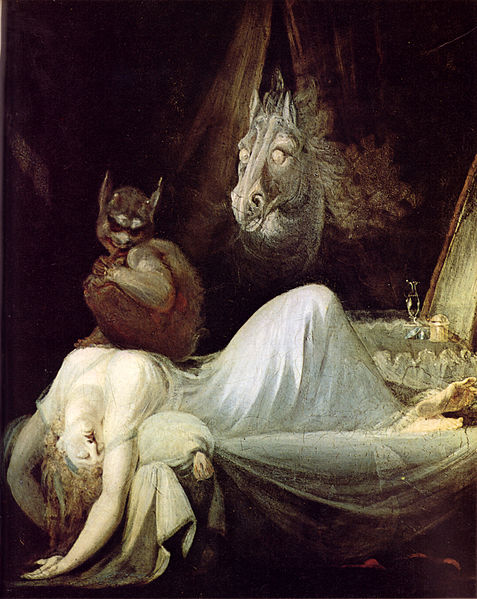Dreaming is a phenomenon that is not well understood or easily explained. There are many theories as to why we dream and what our dreams mean, but it’s difficult to explore and interpret the realm of the subconscious. Despite the fact that dreams are difficult to study, scientists have managed to learn a great deal about these subconscious thoughts and desires. Here are 10 amazing facts about dreams that will truly blow your mind:
The Most Common Dreams Involve Falling, Being Chased, School, Cheating And Your Teeth Falling Out
Since we know that anxiety is the most common emotion experienced in dreams, it’s no surprise that the most common dreams have negative content that would cause anxiety. Dreaming of falling is very common and often correlates to something in your life that is going the wrong direction. Many people also dream of being chased, which has been tied to avoidance. Dreams about teeth falling out are frequently reported and have been connected to your words and communication. People also report reoccurring dreams of their spouse cheating on them, which often has more to do with being "cheated" out of quality time with your spouse than infidelity. Lastly, dreams of being in school are common for adults at any age, which has been linked to work and the pressures from your job.
Nearly 75% Of The Content In Dreams Is Negative
Most dreams won’t leave you happy and smiling. According to research, nearly 75% of dreams contain negative content. The emotions experienced in dreams vary from anger, joy, fear and happiness, but the most common emotion in dreams is anxiety. In addition, negative emotions are more common than positive ones.
Dreaming Helps Relieve Stress
Dreaming help us make sense of the information and events that happen in our lives. Dreams play an important role in processing and memorizing information that we absorb every day. These subconscious thoughts also help relieve stress and even solve problems. It’s very possible to work through real life problems while dreaming at nighttime. They also provide a great deal of important content and meaning that can be used to inspire and direct our lives in the daytime.
Five To 10% Of Adults Have Monthly Nightmares
Nightmares are most common in children between the ages of three or four and seven or eight. Adults have fewer nightmares overall, but they do happen from time to time. According to the International Association for the Study of Dreams, about five to 10% of adults have nightmares once a month or more often.
Blind People Do Not See Visual Images In Their Dreams, But Their Other Senses Are Heightened
Most blind people do not see images when they dream, but they do experience a heightened level of taste, touch and smell in their dreams. Whereas people with normal vision experience intensely visual dreams, but have decreased auditory stimulation and the other senses are mostly absent. Researchers have found that those who lost their sight before age five rarely saw images in their dreams, but those who go blind after age five may continue to see images in their dreams.
About 90% Of Dream Content Is Forgotten After 10 Minutes Of Being Awake
Dreams aren’t easy to recall. Just five minutes after the end of a dream, you are likely to forget half of the content. At 10 minutes, about 90% of the content has been forgotten. It’s not that dreams aren’t important enough to remember, but other things have a tendency to get in the way. As forward thinkers, we often forget things when we first wake up and carry on with our days. There are many plausible theories as to why we forget dreams. Freud believed that dreams were repressed thoughts and desires that weren’t necessary to believe anyway. However, dream researcher, L. Strumpell, theorized that we forget dreams for several reasons, such as a lack of intense dream images, as well as little association and repetition to help us learn and remember.
Animals Also Have Dreams
Scientists at the Massachusetts Institute of Technology discovered that animals do in fact dream and their subconscious thoughts are tied to actual experiences. Animals’ dreams are complex and they are able to retain long sequences of events while sleeping. Animals’ brains share the same series of sleeping states as humans, as well as replaying events or parts of events that happened while awake. Analyzing animals’ dreams and the content of dream states may help scientists more effectively treat memory disorders and develop new ways for people to learn and retain information.
Jacob's dream of a ladder of angels, c. 1690, by Michael Willmann

We Spend About Two Hours Dreaming Each Night
Although your dreams may feel like they last for hours and hours, we only actually spend about two hours dreaming each night. That means a person spends a total of about six years dreaming throughout their lifetime. There are four stages of the sleep cycle and the last stage, called REM sleep, is where almost all dreaming takes place. Each sleep cycle lasts about 60 to 90 minutes and will repeat throughout the night.

We Spend About Two Hours Dreaming Each Night
Although your dreams may feel like they last for hours and hours, we only actually spend about two hours dreaming each night. That means a person spends a total of about six years dreaming throughout their lifetime. There are four stages of the sleep cycle and the last stage, called REM sleep, is where almost all dreaming takes place. Each sleep cycle lasts about 60 to 90 minutes and will repeat throughout the night.
The Most Common Dreams Involve Falling, Being Chased, School, Cheating And Your Teeth Falling Out
Since we know that anxiety is the most common emotion experienced in dreams, it’s no surprise that the most common dreams have negative content that would cause anxiety. Dreaming of falling is very common and often correlates to something in your life that is going the wrong direction. Many people also dream of being chased, which has been tied to avoidance. Dreams about teeth falling out are frequently reported and have been connected to your words and communication. People also report reoccurring dreams of their spouse cheating on them, which often has more to do with being "cheated" out of quality time with your spouse than infidelity. Lastly, dreams of being in school are common for adults at any age, which has been linked to work and the pressures from your job.
Nearly 75% Of The Content In Dreams Is Negative
Most dreams won’t leave you happy and smiling. According to research, nearly 75% of dreams contain negative content. The emotions experienced in dreams vary from anger, joy, fear and happiness, but the most common emotion in dreams is anxiety. In addition, negative emotions are more common than positive ones.
Dreaming Helps Relieve Stress
Dreaming help us make sense of the information and events that happen in our lives. Dreams play an important role in processing and memorizing information that we absorb every day. These subconscious thoughts also help relieve stress and even solve problems. It’s very possible to work through real life problems while dreaming at nighttime. They also provide a great deal of important content and meaning that can be used to inspire and direct our lives in the daytime.
Five To 10% Of Adults Have Monthly Nightmares
Nightmares are most common in children between the ages of three or four and seven or eight. Adults have fewer nightmares overall, but they do happen from time to time. According to the International Association for the Study of Dreams, about five to 10% of adults have nightmares once a month or more often.
There are a number of reasons adults may experience nightmares, such as medications or withdrawal from drugs, as well as physical conditions like stress and illness. Others experience nightmares after a traumatic event that becomes a reoccurring theme. However, some adults have frequent nightmares that are unrelated to their daily lives, which may indicate that they are more creative, sensitive and emotional than the average person.
The Average Person Has About Three To Five Dreams Each Night
There’s no limit to the number of dreams you can have while sleeping, but the average person has about three to five dreams each night. Some people can have up to seven or more dreams in one night. On average, we spend about two hours dreaming during a full eight hours of sleep. Shorter dreams happen in the beginning of the sleep cycle and tend to last longer throughout the rest of the night.
„Nachtmahr“ (“Night-mare”), Johann Heinrich Füssli (1802)

Everyone Dreams, But Not Everyone Recalls Their Dreams
It’s a fact that everyone dreams, but not everyone remembers their dreams. The most vivid dreams occur during Rapid Eye Movement (REM) sleep when the brain is very active and the eyes move back and forth rapidly beneath the eyelids. Dream recall varies from person to person, but some people have little or no recollection of the content of their dream. Since 90% of dreams are forgotten after the first 10 minutes of being awake, the dream content needs to be documented right away. Keep a pen and paper by your bedside and try to write down as much information as possible to find the meaning behind your dreams.
There’s no limit to the number of dreams you can have while sleeping, but the average person has about three to five dreams each night. Some people can have up to seven or more dreams in one night. On average, we spend about two hours dreaming during a full eight hours of sleep. Shorter dreams happen in the beginning of the sleep cycle and tend to last longer throughout the rest of the night.
„Nachtmahr“ (“Night-mare”), Johann Heinrich Füssli (1802)

Everyone Dreams, But Not Everyone Recalls Their Dreams
It’s a fact that everyone dreams, but not everyone remembers their dreams. The most vivid dreams occur during Rapid Eye Movement (REM) sleep when the brain is very active and the eyes move back and forth rapidly beneath the eyelids. Dream recall varies from person to person, but some people have little or no recollection of the content of their dream. Since 90% of dreams are forgotten after the first 10 minutes of being awake, the dream content needs to be documented right away. Keep a pen and paper by your bedside and try to write down as much information as possible to find the meaning behind your dreams.
Blind People Do Not See Visual Images In Their Dreams, But Their Other Senses Are Heightened
Most blind people do not see images when they dream, but they do experience a heightened level of taste, touch and smell in their dreams. Whereas people with normal vision experience intensely visual dreams, but have decreased auditory stimulation and the other senses are mostly absent. Researchers have found that those who lost their sight before age five rarely saw images in their dreams, but those who go blind after age five may continue to see images in their dreams.
About 90% Of Dream Content Is Forgotten After 10 Minutes Of Being Awake
Dreams aren’t easy to recall. Just five minutes after the end of a dream, you are likely to forget half of the content. At 10 minutes, about 90% of the content has been forgotten. It’s not that dreams aren’t important enough to remember, but other things have a tendency to get in the way. As forward thinkers, we often forget things when we first wake up and carry on with our days. There are many plausible theories as to why we forget dreams. Freud believed that dreams were repressed thoughts and desires that weren’t necessary to believe anyway. However, dream researcher, L. Strumpell, theorized that we forget dreams for several reasons, such as a lack of intense dream images, as well as little association and repetition to help us learn and remember.
Animals Also Have Dreams
Scientists at the Massachusetts Institute of Technology discovered that animals do in fact dream and their subconscious thoughts are tied to actual experiences. Animals’ dreams are complex and they are able to retain long sequences of events while sleeping. Animals’ brains share the same series of sleeping states as humans, as well as replaying events or parts of events that happened while awake. Analyzing animals’ dreams and the content of dream states may help scientists more effectively treat memory disorders and develop new ways for people to learn and retain information.
Contacts and sources:
Story by Tina Sans
http://www.onlinedegreeshub.com/blog/2011/10-amazing-facts-about-dreams/
Story by Tina Sans
http://www.onlinedegreeshub.com/blog/2011/10-amazing-facts-about-dreams/








Comments
Post a Comment